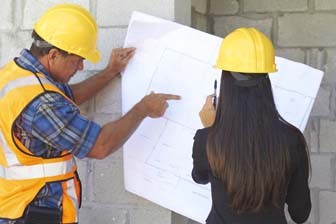How to Become a Construction Manager About this section

New construction managers are typically hired as assistants and work under the guidance of an experienced manager.
Construction managers typically need a bachelor’s degree, and they learn management techniques through on-the-job training. Large construction firms may prefer to hire candidates who have both construction experience and a bachelor’s degree in a construction-related field. Firms might hire as managers those who have a high school diploma and many years of experience in a construction trade; however, these people may be more likely to work as self-employed general contractors than to be hired as construction managers.
Education
Construction managers typically need a bachelor's degree in construction, business, engineering, or a related field.
Bachelor’s degree programs in construction-related majors often include courses in project control and management, design, construction methods and materials, and cost estimation. Courses in business, communications, and mathematics are also helpful.
Some construction managers earn an associate’s degree in construction management or construction technology. An associate’s degree combined with work experience may be typical for managers who supervise small projects.
Candidates who have a high school diploma and several years of relevant work experience may qualify to become construction managers. However, these people may be more likely to work as self-employed general contractors than to be hired as construction managers.
Training
Newly hired construction managers typically work under the guidance of an experienced manager for up to 1 year. Depending on the firm, however, this on-the-job training may last for several years.
Work Experience in a Related Occupation
Construction experience is important for these managers, especially for ones who do not have a bachelor’s degree. For construction managers to qualify for jobs solely through experience, they must have worked many years in carpentry, masonry, or other construction specialties.
College students who participate in internships and cooperative education programs may gain experience through such programs.
Licenses, Certifications, and Registrations
Some states require construction managers to be licensed. For more information, contact your state licensing board. Information on state licensing board requirements is available from CareerOneStop.
Professional certification, although not required, demonstrates a particular level of knowledge and experience. Information on certifications is available from CareerOneStop.
Important Qualities
The following are examples of qualities that are important for these workers to perform their duties. For more information, visit the Employment Projections (EP) skills data page.
Analytical skills. Construction managers must be able to plan strategies, investigate project cost variances, and solve problems over the course of a project.
Business skills. Construction managers need to prepare and follow project budgets, hire and manage staff, and coordinate with other workers and managers. Self-employed construction managers must generate their own business opportunities and be proactive in finding new clients.
Communication skills. Construction managers must be able to clearly convey information orally and in writing. In addition to talking with owners and clients, managers must give clear orders and explain complex information to construction workers and discuss technical details with inspectors and other specialists, such as engineers.
Decision-making skills. Construction managers need to choose personnel and subcontractors for specific tasks and jobs. They also must make myriad judgment calls about projects to ensure that they adhere to deadlines and budgets.
Leadership skills. Construction managers must effectively delegate tasks to construction workers, subcontractors, and other lower level managers to ensure that projects are completed accurately and on time.
Technical skills. Construction managers must have an applied knowledge of concepts and practices common in the industry, such as construction technologies, contracts, and technical drawings.
 United States Department of Labor
United States Department of Labor








